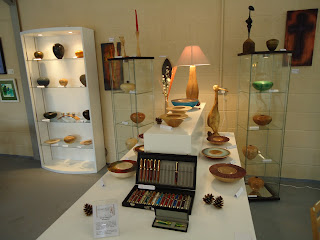Click on pics to make them bigger.
Now we mark the center and fix a 6" face plate on and for added safety i have screwed straps to either side.
Because this is a square it is quite well balanced and i turn it at 350 RPM.
Starting from the center I turn circles at various radius's It is not necessary to make space each circle accurately.
This is done with the only tool I will use for this project a 3/8" spindle gouge.
As you can see I have turned the Headstock to the side and use the Jet free standing tool rest.
The important thing when cutting the circles is to make sure you are cutting not scraping.
If you scrape you will get tear out on the cross overs.
The handle of the gouge is kept low and the cut is at two O clock.
Note the fine shavings this is because the wood is being cut not scraped.
Now we have the first set of circles and as you can see they are spaced wider as i move out.
Having completed as many of the circles as I require the piece is removed from the lathe ready for the next set up.
The two boards are now swapped from side to side ready to commence the next set of circles.
As you can see we now have half circles top and bottom.
Now we can make the next set of circles as the following pic shows.
The piece is removed again and the two boards are sawn in half.
We now have four one foot by one foot squares.
These are placed together and a 6" faceplate fixed.
The faceplate is positioned so that there are two screws in the corner of each square,
For added safety I have attached two straps plus two short ones to keep it all together.
I am keeping to the same lathe speed 350 RPM.
This is now re mounted and the last set of circles turned as the following pic shows.
That is all the turning finished and the piece is ready for coloring.Before i start scorching and coloring I clean up below the lathe to avoid the risk of fire.
That done and the lathe turned off i scorch the whole piece,
This quite a light scorch and very random.
With the piece now completely scorched it is time to apply color.
For my colors I am using Chestnut Spirit stains applied with a diffuser.
This is a method I learned from Nick Agar.
For them that are not familiar with a diffuser it is two pipes set at a 90% angle to each other and by blowing in one with the other in the spirit stain you create a spray.
These can usually be bought in good Art shops.
The first color is Red and applied over the whole piece.I am not worried if it is not uniform as this adds to the final finish.
On top of the Red I have applied Blue then Purple.
Now Yellow is sprayed over the complete piece this softens the colors and makes them blend together.
Three coats of Chestnut Acrylic satin lacquer is applied to the whole piece.
After the Lacquer has dried i apply some more yellow spirit stain.
I put the last coat of spirit stain on top of the lacquer so that it shows up better as it is not soaked into the other colors,
Another three coats of lacquerer has been applied and they are removed from the lathe.
We now have four different but matching wall plaques .
They can now be hung as a set or as you will see in the next pics one large wall plaque.
These are going to be put in a frame which will be made by my mate Richard Fairbrother who is a furniture maker.
We will probably make the frame from MDF and leave it unpainted.
The next pic gives you an idea of what they will look like framed.
Richard will make the frame in the next couple of days so you will have to keep looking to see how it turns out. http://www.richardfairbrother.com/
To be continued























































